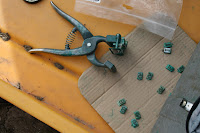As Cattle breeders there are many different ways that we identify our cattle, and since I spent the last two days using many of these tools I thought I would take some time to share some of them that we use with you. Some types of identification are individual to the animal, and some are used just to identify the owner:
| RFID button (image from: http://www.canadianbeef.info/) |
Radio Frequency Identification (RFID) tags: there are 6 types of these tags that are approved by the CCIA (Canadian Cattle Identification Agency) but most people I know use the button type. These tags are like a barcode for each individual animal and it is mandatory for cattle to have them before they can be moved to a different location. These buttons are 15 digits long with the numbers 124 at the beginning to show that the cattle are from Canada. These can be read with an electronic reader which relates them to a database to show where the animal came from, and about the time that it was born. These are to insure traceability in the Canadian food industry.
 Tattoos: I have mentioned before that we tattoo our calves. And no, it’s not some cool design but just a series of numbers and letters that goes in the inside of their ears. All purebred breeders are given an individual prefix. This is a serious of letters that represents your farm (mine is SJO) next comes the number of the calf and then the letter to represent the year (this year’s letter is Y, next will be Z then we start again at A) these tattoos are done using ink and a set of letters, numbers and tattooers (shown left)
Tattoos: I have mentioned before that we tattoo our calves. And no, it’s not some cool design but just a series of numbers and letters that goes in the inside of their ears. All purebred breeders are given an individual prefix. This is a serious of letters that represents your farm (mine is SJO) next comes the number of the calf and then the letter to represent the year (this year’s letter is Y, next will be Z then we start again at A) these tattoos are done using ink and a set of letters, numbers and tattooers (shown left)
 |
| our families brand shortly after it was applied |
Brand: a brand is a way to identify who owns cattle. Each brand is registered with the government of Canada and is individual to the owner. A brand is the most permanent form of identification as ear tags can rip and fall out, and even tattoos are not 100% permanent if the cow’s ear is damaged. The brand is applied using heat and an iron that burns the animals hide
| from: http://southshadow.homestead.com/files |
Dangle tags: on our farm we used green Angus tags. To use these, an animal must be at least 50% Angus. On these tags we put the calves number (same as what is on its tattoo) and in smaller letters we put its mom’s number and who its sire is. Our commercial calves that do not have to use a letter to represent the year that they are born just have their mother’s number on their tag so that we can easily pair the two up. This is our system, but there are lots of ways to do it.
(info from: http://www.canadaid.com/index.html )

We use the same system for tagging calves, It really is the best system. But I might be a little biased.
ReplyDelete